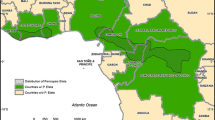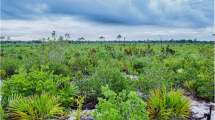Abstract
Daniellia oliveri is an indigenous tree with multiple coppicing that is harvested as firewood by local people from savannas and traditional fallows in West Africa. We investigated the effects of periodic weed removal on D. oliveri resprouting and growth in traditional fallows and its use for firewood production by smallholder harvesters. Protected plots were established in D. oliveri dominated fallows at four sites with contrasting soil types. The weedy control plots experienced periodic fires and grass competition. Sizes of firewood logs were surveyed on local markets and used to estimate the quantity of marketable firewood for each treatment. The species sprouted vigorously, forming pure stands. Leading shoot density on weed-free plots was three times higher, reaching 7,250 ± 454 shoots ha−1 34 months after land clearance when compared to 2,425 ± 215 shoots ha−1 on weedy plots. The weed removal treatment increased shoot height from 18 to 34 months after land clearance, while shoot diameter was not affected. After 24 months, 50% of the shoots were of marketable size for the weedy treatment, while this was reached at 18 months for the weed-free treatment.




Similar content being viewed by others
References
Abbot PG, Lowore JD (1999) Characteristics and management potential of some indigenous firewood species in Malawi. For Ecol Manag 119:11–121
Arnold M, Köhlin G, Persson R et al (2003) Fuelwood revisited: what has changed in the last decade?. Center for International Forestry Research, Jakarta 35 p
Aubreville A (1970) Flore du Cameroun. Volume 9: Légumineuses (Césalpinioïdées). Muséum National d’Histoire Naturelle, Paris 330 p
Aweto AO (1999) Managing natural bush fallows in tropical Africa for improved soil fertilty and fuelwood production. In: Floret Ch, Pontanier R (eds) La jachère en Afrique tropicale: Rôles, aménagement, alternatives, vol 1, Actes du Séminaire International, Dakar, 13–16 Avril 1999. John Libbey Eurotext, Paris, pp 92–96
Bellefontaine R (1997) Synthèse des espèces du domaine sahélien et soudanien qui se multiplient par voie végétative. In: d’Herbès JM, Amboula JMK, Peltier R (eds) Fonctionnement et gestion des écosystèmes forestiers contractés sahéliens. John-Libbey Eurotext, Paris, pp 95–104
Bellefontaine R (2005) Régénération naturelle à faible coût dans le cadre de l’aménagement forestier en zones tropicales sèches en Afrique. Rev Sci Environ 6(2):1–15
Bellefontaine R, Gaston A, Petrucci Y (2000) Management of natural forests of dry tropical zones. FAO Conservation Guide 32. FAO, Rome, Italy, pp 69–166
Bellefontaine R, Sabir M, Kokou K et al. (2003) Revégétalisation, une quatrième voie: la propagation végétative naturelle. Mémoire volontaire. XIIème Congrès Forestier Mondial, Montréal, 8 p
Bond JW, Midgley JJ (2001) Ecology of sprouting in woody plants: the persistence niche. Trends Ecol Evol 16(1):45–51
Boudet G (1977) Pâturages de la zone tropicale humide. Connaissances acquises et besoins de recherches complémentaires. Rev Elev Méd Vét Pays Trop 30(2):175–180
Buhler DD, Netzer DA, Riemenschneider DE et al (1998) Weed management in short rotation poplar and herbaceous perennial crops grown for biofuel production. Biomass Bioenergy 14(4):385–394
Buresh RJ, Cooper PJM (1999) The science and practice of short-term improved fallows: symposium synthesis and recommendations. Agrofor Syst 47:345–356
Cooke P, Köhlin G, Hyde WF (2008) Fuelwood, forests and community management—evidence from household studies. Environ Dev Econ 13:103–135
Crawley MJ (2007) The R book. Wiley, Chichester 942 p
Cuny P, Sanogo S, Sommer N (1997) Arbres du domaine soudanien: leurs usages et leur multiplication. Imprimerie COLOR, Bamako 122 p
Dalle SP, de Blois S (2006) Shorter fallow cycles affect the availability of noncrop plant resources in a shifting cultivation system. Ecol Soc 11(2): Available via http://www.ecologyandsociety.org/vol11/iss2/art2/
Dugan P (2000) Assisted natural regeneration: methods, results and issues relevant to sustained participation by communities. In: Elliott S, Kerby J, Blakesley D et al (eds) Forest restoration for wildlife conservation. International Tropical Timber Organization and The Forest Restoration Research Unit, Chiang Mai University, Thailand, pp 195–199
Dvorak KA (1992) Resources management by West African farmers and the economics of shifting cultivation. Am J Agric Econ 74(3):809–815
FAO (2001) State of forest genetic resources in Sahelian and North-Sudanian Africa and sub-regional action plan for their conservation and sustainable use. Working Paper FGR/2E, Forest Resources Division, FAO, Rome, 107 p
Floret Ch, Pontanier R (1999) La jachère en Afrique tropicale: Rôles, aménagement, aletrnatives, vol 1, Actes du Séminaire International, Dakar. John Libbey Eurotext, Paris, pp 92–96
Franzel S (1999) Socioeconomic factors affecting the adoption potential of improved fallows in Africa. Agrofor Syst 47:305–321
Gleave MB (1996) The length of the fallow period in tropical fallow farming systems: a discussion with evidence from Sierra Leone. Geogr J 162(1):14–24
Hardwick K, Healey J, Elliot S et al (1997) Understanding and assisting natural regeneration processes in degraded seasonal evergreen forests in northern Thailand. For Ecol Manag 99:203–214
Hardwick K, Healey J, Elliot S et al (2004) Research needs for restoring seasonal tropical forest in Thailand: accelerated natural regeneration. New For 27:285–302
Higgins SI, Bond WJ, Trollope WSW (2000) Fire, resprouting and variability: a recipe for grass-tree coexistence in savanna. J Ecol 88(2):213–229
Jegede IA, Nwinyi FC, Muazzam I et al (2006) Micromorphological, anti-nociceptive and anti-inflammatory investigations of stem bark of Daniellia oliveri. Afr J Biotechnol 5(10):930–935
Lykke AM (2000) Local perceptions of vegetation change priorities for conservation of woody savanna vegetation in Senegal. J Environ Manag 59:107–120
Manley RJ, Masse D, Chevallier T et al (2004) Post fallow decomposition of woody roots in the West African savanna. Plant Soil 260:123–136
Mitchell CP, Stevens EA, Watters MP (1999) Short-rotation forestry—operations, productivity and costs based on experience gained in the UK. For Ecol Manag 121:123–136
Mordelet P, Menaut JC (1995) Influence of trees on above-ground production dynamics of grasses in a humid savanna. J Veg Sci 6(2):223–228
Ngobo M, McDonald M, Weise S (2004) Impacts of type of fallow and invasion by Chromolaena odorata on weed communities in crop fields in Cameroon. Ecol Soc 9(2): 1. [online] URL: http://www.ecologyandsociety.org/vol9/iss2/art1
Nyerges AE (1989) Coppice swidden fallows in tropical deciduous forest: biological, technological, and sociocultural determinants of secondary forest successions. Hum Ecol 17(4):379–400
Peltier R (1993) La jachère à composante ligneuse: Caractérisation, productivité gestion. In: Floret Ch, Serpantie G (eds) La jachère en Afrique de l’Ouest. ORSTOM, Paris, pp 68–87
Salzmann U, Hoelzmann P (2005) The Dahomey gap: an abrupt climatically induced rain forest fragmentation in West Africa during the late Holocene. Holocene 15(2):190–199
Sankaran M, Ratnam J, Hanan NP (2004) Tree–grass coexistence in savannas revisited—insights from an examination of assumptions and mechanisms invoked in existing models. Ecol Lett 7:480–490
Sankaran M, Ratnam J, Hanan NP (2008) Woody cover in African savannas: the role of resources, fire and herbivory. Glob Ecol Biogeogr 17:236–245
Sawadogo L, Nygard R, Pallo F (2002) Effect of livestock and prescribed fire on coppice growth after selective cutting of Sudanian savanna in Burkina Faso. Ann For Sci 59:185–195
Scholes JR, Archer SR (1997) Tree–grass interactions in savannas. Annu Rev Ecol Syst 28:517–544
Shackleton CM (2001) Managing regrowth of an indigenous savanna tree species (Terminalia sericea) for fuelwood: the influence of stump dimensions and post harvest coppice pruning. Biomass Bioenergy 20:261–270
Szott LT, Palm CA, Buresh RJ (1999) Ecosystems fertility and fallow function in the humid and subhumid tropics. Agrofor Syst 47:163–196
Wezel A, Böcker R (2000) Vegetation of Benin. In: Graef F, Lawrence P, von Oppen M (eds) Adapted farming in West Africa: issues, potentials, and perspectives. Verlag Ulrich E. Graeur, Stuttgart, pp 219–224
Wickens GE, Seif El Din AG, Guinko S et al. (1995) Role of Acacia species in the rural economy of dry Africa and the Near East. FAO conservation guide 27, FAO, Rome
Williams PJ (1992) NGOs, women and forestry activities in Africa. Unasylva 43(171):41–49
Acknowledgments
We are grateful to Romain Kakai Glele and Valentin Kindomihou for useful comments on an earlier version of this paper.
Author information
Authors and Affiliations
Corresponding author
Rights and permissions
About this article
Cite this article
Houehounha, R., Avohou, H.T., Gaoue, O.G. et al. Weed removal improves coppice growth of Daniellia oliveri and its use as fuelwood in traditional fallows in Benin. Agroforest Syst 78, 115–125 (2010). https://doi.org/10.1007/s10457-009-9265-3
Received:
Accepted:
Published:
Issue Date:
DOI: https://doi.org/10.1007/s10457-009-9265-3




